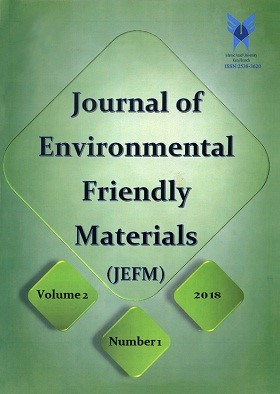Effect of the FSW Tool Pin Profile on Mechanical Properties of the Al6061-Cu Plates Joint
محورهای موضوعی : Journal of Environmental Friendly MaterialsF. khalili 1 , K. Amini 2 , M. Golzar Shahri 3 , F. Gharavi 4
1 - Advanced Materials Research Center, Department of Materials Engineering, Najafabad Branch, Islamic Azad University, Najafabad, Iran
2 - Advanced Materials Research Center, Department of Materials Engineering, Najafabad Branch, Islamic Azad University, Najafabad, Iran
3 - Advanced Materials Research Center, Department of Materials Engineering, Najafabad Branch, Islamic Azad University, Najafabad, Iran
4 - Department of Materials Engineering, Sirjan Branch, Islamic Azad University, Sirjan, Iran
کلید واژه:
چکیده مقاله :
In current research, the Friction Stir Welding (FSW) technique was used to create a metallurgical joint between Al 6061 plates and Cu meat core. The plates were welded using single pass weld with the rotational speed of 1000 rpm and arc travel speed of 30 mm/ min using different tool pin profiles of cylinder, triangle, and hexagonal. After the rolling process and reaching to 1.7 mm of thickness, to evaluate whether there was no separation in layer plates, the radiography test was applied. For more investigation of the created metallurgical bond, optical microscopy (OM) and scanning electron microscopy (SEM) were used. Studies on the welded samples showed a perfect metallurgical bonding. The bonding thickness between Al plates and the Cu meat sample in the samples with pin profiles of triangle, cylinder and hexagonal shape were estimated to be 30, 39 and 45 µm, respectively. Moreover, in comparison to the FSW samples with triangle and cylinder pin profile, the microhardness and ultimate tensile stress were higher in the FSW samples using hexagonal pin profile. It was owing to the fact that hexagonal pin profile had a larger contact area compared with the other two pins. Therefore, the mechanical work using hexagonal pin was more, resulting in an increase in the hardness and tensile stress. In addition, material flow in the bonding zone increased and contributed to an increase in the width of the joint area
[1] F. Nascimento, T. Santos, P. Vi.la, M .Miranda, L. Quintina, Mater. Sci. Eng. A, 506(2009), 16.
[2] R. Sathiskumar, , N. Murugan, , I. Dinaharan, ,S.J. Vijay , Indian Acad. Sci., 38(2013), 1433.
[3] Ozaltun H., Herman Shen M.-H., Medvedev P, J. Nuclear Mater, 419(2011), 76.
[4] G.A. Moore, F.J. Rice, N.E. Woolstenhulme, 30th International Meeting On Reduced Enrichment for
Research and Test Reactors: USA, (2008).
[5]J. Lisboa, J. Marin, M. Barrera, H. Pesenti, World J. Nucl. Sci. Technol.,(5)2015, 274.
[6] C.R. Clark, N.P. Hallinan, J.F.JUE, "Monolithic uel Fabrication Process Development": USA, (2006).
[7] J. Wight, G.A. Moore, "Testing and Acceptance of fuel Plates for RERTR Fuel Development Experiments":
30th International Meeting on Reduced Enrichment for Research and Test Reactors USA, (2008).
[8] D. Keiser Jr., J. Jue, B. Miller, J. Gan, Metal. Mater. Trans. E, 2E (2015), 173.
[9] T. Santos, P. Vila, L. Quintino, Welding in the World, 53(2009), 5.
[10] V.S. Gadakh, A. Kumar, G.J. Vikhe Patil, welding, 94(2015), 115.
[11] Ch. Venkata Rao, G. Madhusudhan Reddy, K. Srinivasa Rao, Defense. Technol., 11(2015), 123.
[12] P. Kush, J. Vishvesh, Int. J. Adv. Manuf. Technol., 80(2015), 2073.


